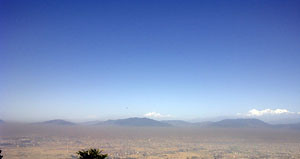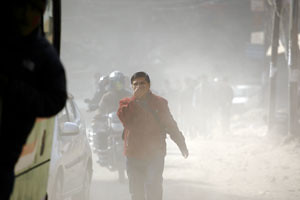
KUNDA DIXIT
Forty-year-old Ali Akhtar never leaves home without what has become an essential accessory for most Nepalis: his brown cloth mask.
As the streets around his fabric shop in Jawalakhel are demolished for road widening and the neighbourood becomes shrouded in a cloud of yellow dust, Akhtar is trying his best to protect himself from the pollution and keep his business running.
While Beijing made headlines this week for the worst air quality on record (see box), Kathmandu Valley is not far behind. The average PM 10 count concentration in Kathmandu, a measure of particulate matter content in the air, was 183 ug/m3 in 2003 and 173 ug/m3 in 2007, both far above the WHO standard of 50 ug/m3 and the US National Ambient Air Quality Standard of 100 ug/m3.

PICS: BIKRAM RAI
There is no data beyond 2007 because the seven
monitoring devices installed by DANIDA across the Valley in 2002 to measure PM levels have been out of order for the past four years. Without the units, there is no mechanism to monitor and warn citizens to take extra precautions during bad days. The Department of Transportation, however, has said it is going to repair four of the stations by next month.
While mismanaged waste and unplanned urbanisation contribute to the city’s air pollution, vehicle exhaust and brick factories are the biggest polluters. Fumes from the 60,000 plus vehicles plying on the choked roads of the Valley add the most toxins. The road expansion drive has only made things worse.
Anjila Manandhar from
Clean Air Network Nepal says that instead of improving air quality, the government has aggravated the problem: “They just tore down houses and roads, nobody thought about how to get the job done with the least amount of pollution and there were no cleanup efforts either.”
In winter, the Valley’s topography creates a cold inversion layer that traps warm and polluted surface air, trapping dust and smog. “Air pollution has become a huge problem and it gets worse during the winter,” says Buddha Basnyat, a doctor at Patan Hospital, “we have long queues and ward full of patients with respiratory problems at this time of the year and children suffering from asthma are also on the rise.”
Every year the government spends more than $ 21 million in medical bills for pollution related illnesses. Street vendors, construction workers, road workers, and traffic police who are exposed the longest to the smoke and dust face the greatest risk along with those who attend schools, colleges, and offices located along major roads.
According to a recent study conducted by the
Nepal Health Research Council the average PM 2.5 (the smallest pollution particles) around a school in Jawalakhel located next to the road was 200 ug/m3, significantly higher than the WHO threshold, and the national standard of 40 ug/m3.
Arjun Karki, a pulmonologist at Patan Hospital, says pollution is not only harmful in terms of health, but stunts the country’s economic growth. “When an adult falls sick, the family risks losing its source of income, productivity goes down, expenses go up and sometimes the family is pushed into poverty,” explains Karki. Streetfront shops like Akhtar’s lose business when pollution is higher.
While the road widening campaign is partly to blame for the thick clouds of brown dust in Kathmandu, lack of government control and monitoring is also responsible. The state introduced a Vehicle Emission Standards (VES) test in 1995, and those four wheelers which passed were given green stickers. Similarly the ban on vehicles older than 20 years was announced in 2000.
However, many government vehicles don’t have stickers and not all those that do have actually passed the test. Corruption is rife and the traffic police hardly checks the validity period. And despite repeated attempts to stop the worst offenders, the state hasn’t been able to enforce the ban on old vehicles plying on the roads of Kathmandu.
In the absence of clear environmental guidelines, industries are free to let off massive amounts of smoke into the atmosphere without any repercussions.
Brick Clean Network is an exception. It has introduced a
new certification system for brick factories to encourage them to remove exploitation and pollution.
“The pollution is making us sick, affecting our incomes, and turning Kathmandu into a very unpleasant city. But our leaders are so busy with power politics, they don’t care,” says Akthar as he puts on his mask and gets ready to go home.
See also:
Lost in the smog, DEWAN RAI and SUVAYU DEV PANT
The government doesn't seem to care about Kathmandu's worsening air pollution
To see the video What's in air pollution click here
Between Beijing and Delhi
Beijing cleaned up its air for the 2008 Olympics after facing international criticism. Power plants installed scrubbers, emission controls were introduced so athletes and spectators could inhale fresh air. However, once the games were over, things got back to ‘normal’. And this week on 12 January
Beijing residents suffered a day of shockingly bad air with the capital shrouded in thick haze. Beijing witnessed off-the-chart reading of 755 on the Air Quality Index, which maxes out at 500. Any reading above 100 is deemed ‘unhealthy for sensitive groups’ while anything above 400 is rated ‘hazardous’ for all.
Meanwhile, in the Indian capital winter air quality is also steadily worsening after almost a decade of improved policies that raised emission standards, closed polluting industries, and expanded green spaces. The visibly improved air quality has taken a downturn with fine-particle pollution rising by 47 per cent in the last decade and nitrogen dioxide levels up by 57 per cent. It made a costly investment to convert the city’s buses and auto rickshaws to compressed natural gas, but environmentalists say New Delhi now needs aggressive second generation reforms to improve air quality.
How effective is your mask?
Most Kathmandu commuters don masks or hold a handkerchief to their mouths when out on the streets, but these barely provide any protection in this dust bowl. Larger particulate matters above 10 microns (PM 10) are trapped in the nose and mouth, but the finest and most deadly particles, PM 2.5, lodge themselves deep in the lungs.
About 30 times thinner than human hair, PM 2.5 easily penetrates generic masks found in the market. Masks designed for industrial use or professional cyclists and bikers provide better protection and are available in Kathmandu or online, but at Rs 1,500 a piece, they are beyond the reach of most Nepalis. However, considering the health costs, investing in a mask could be worthwhile in the long-term.
| WHICH MASK? |
| Type of mask |
Price |
Effectiveness |
| Cotton handkerchief |
Rs 20 |
28% |
| Cyclist mask 1 |
Rs 1,500 |
55% |
| Surgical mask |
Rs 15 |
80% |
| Cyclist mask 2 |
Rs 4,000 |
83% |
| 3M Dust Respirator |
Rs 1,400 |
96.6% |
| Teflon filter |
Rs 2,500 |
99.34% |
| Source: Beneficial cardiovascular effects of reducing exposure to particulate air pollution with a simple facemask |
Environmental Kuznets Curve
The Environmental Kuznets Curve draws an inverse relation between a country’s income and pollution. Growing industrialisation leads to increased levels of pollution, but once the country’s GNP crosses a certain threshold, its capacity and willingness to adopt greener alternatives rises and it becomes more eco-friendly.
One dusty morning in Kathmandu, a photo gallery by Bikram Rai
Pollution in Kathmandu has become a major problem for its residents who try their best to protect themselves from the dusty streets of the Valley.